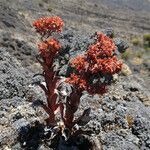Leaves 2·5-26·5 x (0·1-0·2) 0·4-2·7(3·3) cm., sometimes up to 37 times longer than wide, the basal ones the longest and rosulate, oblong-to linear-lanceolate or linear, ± attenuate, the lower cauline leaves similar to the basal ones but shorter, the succeeding ones lanceolate or linear to oblong-or ovate-lanceolate, the uppermost sometimes bract-like, all acute or subacute at the apex, entire and with a row of short, contiguous, obtuse, white papillose cilia at the margin, sessile, ± long-connate at the base, clasping the stem below, then subappressed to it, finally erect or somewhat arched, flat, fleshy (but not very thick), pale to bright green when fresh, greenish-brown or dark brown when dry, usually glabrous on both faces or very rarely papillose-hairy beneath or on both surfaces; sheath (0·5)1-3 cm. long in the lower cauline leaves, shortening in the following; all internodes shorter than the leaves (sometimes the stem completely concealed by the sheaths and the clasping part of the laminas) or the upper ones subequalling or longer than them.
Perennial herb, succulent, with one rosette, leaf pairs spirally arranged, old ones remaining on stem, ± 0.5 m high when flowering, tuberous rootstock. Leaves lanceolate to linear-triangular, 5-250 x 6-20 mm, acute, drying from apex, dorsiventrally flattened, grooved above, glabrous except for stout marginal cilia, green to yellowish green. Inflorescence a flat-topped thyrse, many pedicellate flowers; peduncle with leaf-like bracts, shortening upwards. Calyx fleshy, acute drawn into stout hair, with few marginal teeth, yellowish green. Corolla tubular, fused 0.5-1.0 mm, yellow to white; lobes oblong to oblanceolate, 2.5-5.0 mm long, obtuse, slightly hooded, recurved. Flowering time Jan.-Apr.
Stem arising from a fleshy to woody obconical or swollen tuber, erect, straight, usually simple, ± stout (up to 10 mm. in diameter at the base) or sometimes ± slender, terete, pale-or yellow-green below, bright red to reddish-brown above, usually crimson on drying, glabrous towards the base, papillose-hairy or shortly papillose upwards below the nodes along two ± short stripes alternating with the lamina of the leaves (the papillae usually very short, patent, obtuse or, if long, then hair-like), or completely glabrous, rarely papillose throughout.
Calyx (1)1·5-3(4) mm. long, 1/3-1/2 (2/3) as long as corolla, rarely subequalling it, pale green; sepals ovate-lanceolate or ovate-elliptic to linear-lanceolate, not or ± attenuate, acute, with one terminal ± long obtuse papilla at the apex, usually entire and without marginal papillae or sometimes obtuse papillae present over a short to ±: long extent of the margin as well as on the median nerve above.
A succulent herb. It can grow 90 cm high. It forms clumps about 90 cm across. The stem rises from a fleshy swollen tuber. The stem is straight and erect and simple. The leaves are 3-26 cm long by 1-3 cm wide. They are narrow. The leaves near the base are the longest. The flowers are in a dense head. This can be 2-22 cm across. The fruit is a follicle with small seeds.
Corolla (2·25)2·5-3·5(4·5) mm. long, white, pinkish-white or cream-white, sometimes red-tipped, or yellow, rarely red; petals 0·75-1·5(2) mm. wide, elliptic-oblong to ovate-oblong or ovate, obtuse or nearly so, slightly thickened at the top, not or indistinctly mucronate below the apex, smooth.
Flowers 5-merous in a repeatedly dichotomous, usually very dense, subhemispherical, corymbose inflorescence, 1·5-22(30) cm. in diam.; branches ± papillose to nearly glabrous; pedicels 2-6 mm. long, glabrous or sparsely papillose.
Follicles (incl. styles) 2-2·5(2·75) mm. long, contracted into the very short styles.
A succulent, 8-90 cm. high perennial, forming clumps up to about 90 cm. in diameter.
Filaments 1·5-2 mm. long; anthers (0·25)0·3-0·4(0·5) mm., subcircular.
Seeds c. 0·5 mm. long, oblong.

